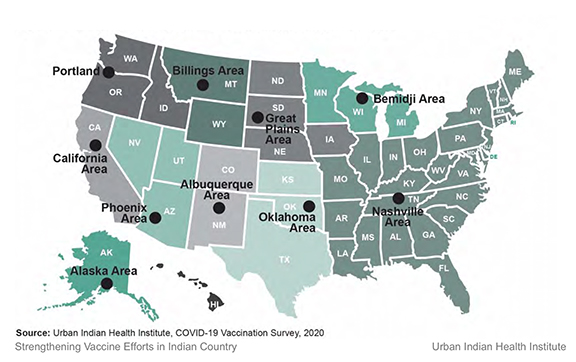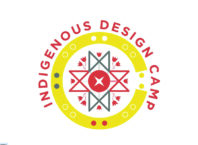
By Lee Egerstrom
As January came to a close, greater supplies of COVID-19 vaccines were reaching Minnesota and there were signs Native Minnesotans were rolling up their sleeves to receive the life-saving vaccinations.
State health officials were still concerned about the slow pace of receiving vaccine. Programs are in place for getting supplies to the most vulnerable, such as front line workers, healthcare providers and the elderly – especially those in long-term care facilities.
At the same time, there were positive signs that the vaccine is getting out of bottles and into arms. That was true in Minnesota’s tribal and urban Native communities.
Tribal clinics and hospitals connected through the federal Indian Health Service began administering the Pfizer-BioNTech and Moderna vaccines to tribal leaders, emergency workers and caregivers more than a month ago.
Elsewhere, clinics and specially established vaccination sites were providing inoculations for health and emergency workers, teachers and others who must be in contact with people in their work. Especially vulnerable people in assisted living arrangements were also placed in early vaccination schedules.
Minnesota established a lottery system on Jan. 26 for people 65 and older to schedule vaccinations. More than a quarter of Minnesotans (226,244) in that age group signed up that first day. There are 919,000 Minnesotans in that age group.
Major healthcare providers, such as large Bloomington-based HealthPartners, were contacting seniors in the final days of January to schedule vaccination appointments.
Among clinics receiving early supplies of the vaccines was the Native American Community Clinic (NACC) at 11213 Franklin Ave., Minneapolis. A receptionist said Jan 29 that NACC had reached its 65 and older patients and was starting to vaccinate people 55 and older.
In Northern Minnesota, the Fond du Lac Band was scheduling vaccinations for members 52 and older although it warned on its website that vaccine supplies are limited.
The White Earth Nation announced to its members it would vaccinate resident individuals 45 and older in early February, and individuals 18 to 35 who have various health conditions.
Eligibility information is provided on the tribal websites.
State health officials have distribution systems in place for the general public although vaccine supplies are still insufficient. At the current pace, Minnesotans and most Americans are months away from inoculation.
On a state website, linked below, health officials said Minnesota is receiving 60,000 doses of vaccine per week. With a population of 5.6 million, the supply is only 1 percent of what is needed.
“We encourage Minnesotans to remain patient as more vaccine arrives in the weeks and months ahead,” they said.
There was hope at month’s end more supplies will be coming. Johnson & Johnson, another drug maker, was readying a COVID vaccine that would be a single shot. The Pfizer and Moderna vaccines require two shots. The Johnson & Johnson vaccine has a longer shelf life and doesn’t need to be kept in a frozen state until being used.
The Centers for Disease Control and Prevention (CDC) says clinical trials are underway or being planned for three additional vaccines (AstraZeneca, Janssen and Novavax). With variants of COVID strains appearing around the world and turning up in Minnesota, a serious race is underway to match vaccine supplies with demand.
CDC and state health officials have been concerned that Native Americans and people from other communities of color may be reluctant to take the vaccinations. Research shows this is the case in some states and especially within some Black communities.
A new study by the Urban Indian Health Institute (UIHI) a tribal epidemiology center based in Seattle, has found that 75 percent of Native American and Alaskan Native people are willing to receive the COVID-19 vaccine and 74 percent said getting vaccinated was their responsibility to their community.
A survey of the general U.S. population in October found 64 percent was willing to receive the vaccine. It should be noted, however, that much more information about the vaccines have become available since the national survey last fall.
The new UIHI survey was conducted among various tribal affiliations in 46 states, including Minnesota.
“The data indicates that most Native people willing to be vaccinated feel it is their responsibility to the health of their community,” said Abigail Echo-Hawk, UIHI director. “This shows what motivates our community when it comes to decision making.”
Fear and distrust of government and medical systems still exists in Native communities, Echo-Hawk said. At the same time, Native communities have much at stake with the current pandemic.
COVID-19 incidence and mortality rates for Natives are 3.5 and 1.8 times higher than for non-Hispanic Whites, the institute noted.
Among other findings from the survey, 89 percent of participants want evidence that the vaccine is safe for now and the long term, and 75 percent willing to get vaccinated had concerns about potential side effects.
Given the remoteness of many tribal communities, and age and health of many elders, the survey found what might have been suspected – 39 percent of participants have trouble traveling to their clinic for an appointment,
In other data, the survey found that 90 percent of participants unwilling to get vaccinated still recognize COVID-19 as a serious disease, and 89 percent unwilling to receive the vaccine were concerned about potential side effects.
“This data will be important to all organizations conducting COVID-19 vaccine education efforts,” Echo-Hawk said in releasing the survey. “Native communities have unique challenges and needs that usually are not considered in public health campaigns.”
The UIHI study can be accessed at
https://www.uihi.org/projects/strengthening-vaccine-efforts-in-indian-country.
Information on the vaccines themselves is available at
https://www.cdc.gov/coronavirus/2019-ncov/vaccines/different-vaccines.html.
Minnesota Department of Health vaccine and COVID information is available at https://www.health.state.mn.us/diseases/coronavirus/vaccine/index.html;
and an explainer, “Who’s Getting Vaccinated” is at
https://mn.gov/covid19/vaccine/whos-getting-vaccinated/index.jsp.






